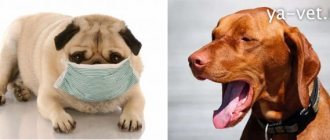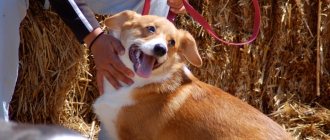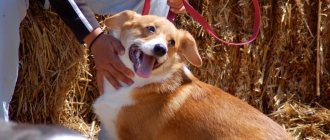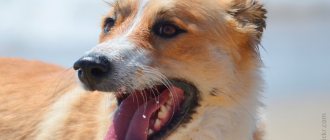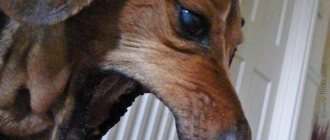Your dog has started coughing. What with her? Got a cold, choking or heart problems? The causes of cough in a dog can be very different, so you need to find out what happened to your pet and start treatment.
There is no need to delay the start of the examination, since coughing causes great discomfort to the dog and can be the first sign of complex and life-threatening diseases.
What kind of cough does a dog have?
Coughing is a protective reflex, with the help of which all irritating factors are removed from the respiratory system, while when the glottis is closed, intrathoracic pressure increases, and then a sharp exhalation follows.
A reflex cough in a dog is caused by foreign bodies or mucus irritating the vagus nerve located in the respiratory tract. From it, a signal goes to the cough center, which provokes a cough. In this way, the body is cleansed of everything unnecessary that appears in the lungs, bronchi or larynx.
Wet and dry cough in dogs are distinguished by whether it is accompanied by mucus secretion or not. A wet cough is the result of acute inflammation, which provokes excessive mucus secretion and its accumulation in the bronchi. With a dry cough, there is little sputum, and most often it accompanies a chronic disease.
Depending on how long the cough lasts in dogs, it is classified as rare, frequent or constant.
Depending on the force with which an animal coughs, we can talk about a weak, strong, superficial or deep cough.
In some diseases, the cough is very painful, so the dog makes attempts to suppress it so as not to hurt itself again.
Symptoms of illness
Any disease has characteristic features, according to which the veterinarian makes an accurate diagnosis. Dangerous to the health of the animal is a severe, constant cough, which is combined with the secretion of foam, saliva and is expectorant in nature. The pet sticks out its tongue and makes movements as if expelling a foreign object from its throat.
Most often, such a cough is a signal of some kind of illness or injury. The accompanying signs confirming the pathology include the following options:
- The pet burps, and at the same time a copious discharge of mucus from the nose or foam from the mouth begins.
- The animal begins to rapidly lose weight. There is practically no appetite.
- Activity decreases to almost zero. The pet is depressed, tries to hide, does not want to go for a walk.
- The dog breathes unevenly even with slight physical exertion.
- The four-legged wheezes heavily and sneezes frequently.
- The gums bleed and sores appear on them.
- The temperature rises, chills and trembling appear.
If these symptoms occur, you should be seriously concerned: most likely, the dog is getting sick. He needs to be taken to a veterinary hospital and tested.
Why does the dog cough?
Many diseases cause coughing in dogs:
- Ingestion of foreign objects into the respiratory system.
- Infections transmitted from other dogs.
- Problems with the lungs and bronchi.
- Filling the pleural area with fluid or air.
- Throat diseases.
- Worm infestation.
- Oncological diseases.
- Problems with gums and teeth.
- Hereditary diseases.
- Problems associated with the structural features of the muzzle.
- Cardiovascular diseases.
- Allergic reactions.
Only after identifying the causes of the cough are treatment tactics for the dog determined and the duration of therapy is determined.
Infectious tracheobronchitis
Another name is kennel cough, a respiratory disease in dogs that occurs in an acute form. Pathology provocateurs are a complex of bacterial and viral pathogens.
The disease becomes widespread in nurseries, packs of stray dogs, shelters, and anywhere where sanitary standards for keeping pets are not observed.
The main symptoms resemble pharyngitis, bronchitis, the dog coughs in fits and starts, grunts through its nose, there is discharge from the eyes and nose, and the regional lymph nodes are enlarged.
Aviary cough with a strong pet’s immunity and timely transfer to good housing, feeding occurs on its own. With the development of secondary infections and non-compliance with hygiene rules in the premises, death is possible.
The main types of cough in dogs and how to treat cough in dogs
Cough caused by viral diseases
Dogs can infect each other with infections. Viral tracheobronchitis or “kennel cough” is one of these diseases. From the second name it is clear that this disease often affects animals that live crowded in a nursery and become infected from each other.
The main causative agents of viral tracheobronchitis are:
- mycoplasma;
- Bordetella bronchiseptic;
- pseudomonas;
- Klebsiella pneumonia.
When infected with tracheobronchitis, the dog develops a cough as if it was choking. It is deep, dry, very frequent and greatly exhausts the dog. Some animals sneeze, snort, gag, regurgitate white foam, and sometimes vomit. At the same time, the dog eats poorly, becomes lethargic, and if you look into his throat you can see enlarged tonsils.
From the moment of contact with a sick animal to the appearance of the dog’s first cough, it takes from two days to two weeks, this depends on the immunity of the infected dog. All breeds of dogs and animals of any age are susceptible to the disease.
Tracheobronchitis usually occurs in a mild form and the dog recovers in two to three weeks, but in some cases complications such as pneumonia can occur. If the dog has been coughing for a long time and the cough becomes more severe, shortness of breath appears, and mucus and blood are coughed up, then an urgent trip to the veterinarian is necessary to prevent serious consequences.
In breeds that have a narrowed trachea, the cough can last more than three weeks, so in this case it is better to play it safe and consult a veterinarian to rule out a complication.
How to treat a dog's cough with tracheobronchitis?
If the course of the disease is mild enough, then you need to give the dog’s immunity a chance to cope with the infection on its own. If the animal is not feeling well, it is necessary to use not only antitussive medications to alleviate the condition, but also add expectorants to prevent the stagnation of mucus in the bronchi. In severe cases, antibiotic therapy is used.
What else should you do if your dog is coughing as if he is choking? The animal needs a lot of rest, its diet should be varied and enriched with vitamins. It is advisable that the air in the house where the sick dog is located is warm and humidified.
Main causes of difficulty breathing
Let's consider the main causes of difficulty breathing, which are most often encountered in the practice of veterinarians around the world. Of course, in the first place are the common “colds”, which sometimes also affect dogs.
In the simplest cases, it’s all about rhinitis:
- The mucous membrane of the nose and other parts of the upper respiratory tract first becomes inflamed due to the activity of pathogenic and conditionally pathogenic bacterial microflora.
- Inflammation leads to the development of swelling.
- The respiratory passages narrow, which is why the dog can no longer breathe deeply, sniffles and groans.
But this is one of the easiest and relatively harmless reasons. It happens that simple rhinitis goes down, resulting in inflammation of the lower parts of the respiratory system. This is how bronchitis or even pneumonia often occurs.
Breed predisposition
We will look at more “specific” cases. This includes breed predisposition. If a person has ever encountered the following breeds, then he knows how their typical representatives sniff and grunt:
- Bulldogs, especially English ones.
- Some mastiffs.
- Pugs, etc.
All these animals are united by the same circumstance: they are all brachycephalic, i.e. dogs with short and flattened muzzles. It just so happens that it is very problematic to deceive nature and physics, and therefore in such animals the structure of the respiratory system is far from anatomically correct. And therefore the same bulldogs will hiss, grunt and grunt all the time. And the older such a pet is, the more clearly all this will manifest itself. Nothing can be done about it.
Owners of such dogs must comply with the following rules:
- There is no need to walk with your pet if the weather is too hot or too cold.
- The room where such a “pig” is kept must always be maintained at optimal temperature and humidity. In the south, by the way, air conditioning would be a good idea.
- Bulldogs, in principle, are not fans of long walks, and therefore there is no need to walk with them for three hours.
Chest trauma
It happens that the cause of difficulty breathing is a chest injury. Therefore, in cases where the dog was hit by a vehicle, got into a fight, or simply returned home covered in blood and with other signs of injury, special attention should be paid to the presence/absence of the following symptoms:
- Wheezing.
- Prolonged and “metallic” cough.
- Pain on palpation of the chest.
- Discharge of foamy exudate or even blood from the mouth and respiratory passages.
The injuries themselves vary and the causes of difficulty breathing also vary. But nevertheless, the general “mechanics” of such phenomena can almost always be identified:
- Severe bruise of the muscles responsible for contracting the chest during breathing. If they are knocked off and hurt, the dog will not be able to breathe normally and will try to take deep breaths, since they cause pain when injured.
- Fractured or cracked ribs . Moreover, any inhalation can cause serious pain to the dog, and therefore breathing becomes shallow, wheezing and very frequent.
- Lung contusion. In this case, the animal also cannot breathe normally, and pulmonary edema may develop. When inhaling and exhaling, wheezing, hissing, and grunting are heard.
- Due to the fracture of the ribs, their fragments tore the pleura or damaged the lungs themselves. At the same time, any inhalation or exhalation causes severe pain to the pet. Breathing becomes hoarse, hoarse and shallow, rapid, blood and/or bloody foam is released from the mouth and respiratory openings.
Important! If you suspect a chest injury, you should immediately call a veterinarian!
Asthma
As in the case of humans, asthma in animals causes many serious problems for the latter. This disease is characterized by a sudden, spastic narrowing of the bronchi, as a result of which normal breathing becomes impossible. The cause of the disease still remains not fully understood, but it is known for sure that allergies almost always contribute to its occurrence. There are also predisposed breeds, which include almost all varieties of poodles and lapdogs.
Treatment
If possible, the causes of the dog's choking should be identified and eliminated. If the cause is environmental (cold/heat), then try to eliminate this problem as well. • While searching for the underlying cause of difficulty breathing, supportive therapy is prescribed. • Oxygen therapy or oxygen therapy • Antibiotics or anti-inflammatory medications may be prescribed to animals with infectious diseases or inflammation.
• In case of dehydration, appropriate therapy is prescribed.
[custom_ads_shortcode3]
How to understand that you are sick
To confirm the diagnosis, methods are used that detect either viral RNA in samples (in saliva) or immunoglobulins (circulating in the blood) that are produced in response to the virus. But tests are not 100% accurate, so they can be done several times. Also, additional imaging methods (CT, X-ray of the lungs) help make an accurate diagnosis.
You can suspect an asymptomatic course in family members where there is at least one infected person and everyone else has close contact with him. But only tests can confirm this for sure if there were no symptoms.
Health care
Before hospitalization the following is performed:
- breathing control. To ensure ventilation of the lungs, the oral cavity is cleared of vomit, and the tongue is fixed with a holder. It is possible to use an airway; in case of coma, intubation is necessary;
- gastric lavage. If the patient is unconscious, it is performed through a probe;
- maintenance therapy. Intravenous administration of glucose solution, vitamins, insulin or other drugs - the set is determined by the patient’s condition;
- symptomatic treatment. Relieving pain, restoring normal breathing, lowering blood pressure, etc.;
- if the body temperature is low, the person freezes - warming up (with heating pads).
After providing primary care for acute ethanol poisoning, doctors at the NarcoDoc clinic recommend hospitalization in a hospital. In the clinic, they continue to monitor the patient’s condition, treat him, and relieve possible complications of intoxication.
Contact our specialists for treatment of alcoholism followed by rehabilitation, call: +7
General tips on how to help the body cope with illness
For any disease of the respiratory tract, including tracheitis, you should follow some simple rules.
- Drink more warm liquids: fruit drinks and heated mineral water without carbon, decoctions of rose hips, raspberries and linden blossoms. This will not only help relieve intoxication, but will also help thin the sputum.
- Eat high-calorie, vitamin-rich foods. During illness, the body needs nutrients to repair tissue and maintain the functioning of the immune system.
- Stop smoking and ask family members to smoke only outside the home.
- Eliminate irritating factors: smoke, dust, strong odors. During illness, it is advisable not to use household chemicals and temporarily stop using perfumes and eau de toilette.
- Ventilate the room and maintain a sufficient level of humidity. Dry air irritates the mucous membrane of the respiratory tract and provokes coughing attacks.
With timely treatment, tracheitis resolves within 10–14 days, without leaving any consequences and without subsequently limiting the ability to work.
What to do
If you suspect you have coronavirus or have been in contact with someone who is sick, you must self-isolate for 2 weeks. If necessary, take tests for COVID-19. The main thing during this period is to limit your contacts with others and not expose them to unnecessary risk. If symptoms appear, consult a doctor.
If you suspect you have coronavirus or have been in contact with someone who is sick, you must self-isolate for 2 weeks.
Anatomy and breed specifics
Almost all owners of brachycephalic dogs claim that their pet makes “indecent” sounds, sniffles, grunts and snores. This is explained by the specific structure of the pharynx, the soft palate, which, over the course of life, relaxes and falls down, blocking the natural flow of air. Due to selection and reduction in the volume of the skull bones, soft “excess” tissues are collected in folds not only outside (Shar Pei), but also inside. This is inherent:
- French and English bulldogs.
- Pugs.
- Shar Pei.
- Japanese Chin.
Pomeranians and Yorkies are also characterized by similar grunting sounds, although they have a rather elongated and miniature muzzle. The sound increases during physical activity, after 5 years (weakening of tissues), during heat, and excitement. With the development of brachycephalic syndrome, shortness of breath, snoring and grunting sounds occur even when the pet is completely at rest.
Dirofilariasis
Dirofilariasis is damage to the arteries and the heart itself by heartworms. The disease is transmitted through blood-sucking insects and is life-threatening for the pet. Symptoms are similar to those of heart disease:
- apathy and drowsiness;
- cough, difficulty breathing, shortness of breath;
- fainting;
- swelling of the forelimbs and lower part of the sternum.
Heartworm infection in dogs causes nausea and vomiting. When left untreated, this disease can be fatal. Treatment and dosage of drugs is prescribed by a veterinarian and carried out under his supervision.
